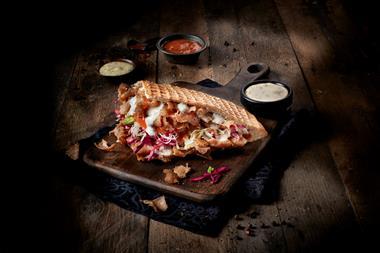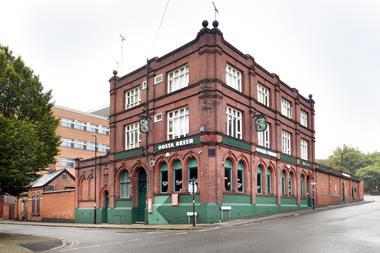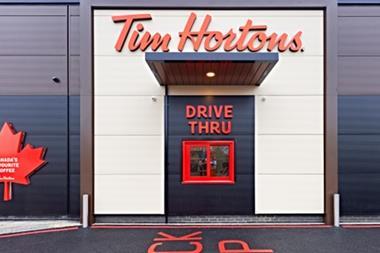Analysts at Liberum have given their view of the current market and their top picks for the sector, highlighting the potential for premium wet-led venues.
They said: “The latest round of trading updates largely played out as expected, with premium and wet-led brands outperforming their more value-food focussed peers.
“The outlook remains cautious, with soft demand and rising costs now well flagged and largely baked into forecasts - important as we approach the next labour/rates hikes in April.
“In this review, we look beyond LFL sales trends to consider the impact of discounting, supply and margin trends, and valuation.
“Against this backdrop, the winners will be those with the operational and financial flexibility to invest, innovate and steal market share. Here we see City Pub (BUY, TP 200p) as best placed. More controversially, we see the de-rating of Greene King (BUY, TP 690p) and Marston’s (BUY, TP 140p) as being overdone, especially in light of their freehold backing and ‘pub’ core. This is in contrast to JDWetherspoon (HOLD, TP 1330p) and Mitchells & Butler (SELL, TP 210p) where we think valuations do not reflect the margin and cash flow risks, respectively. We view Restaurant Group (BUY, TP 430p) as a recovery play and Domino’s Pizza (SELL, TP 250p) as a special situation.”
The note goes on to say:
The most recent round of trading updates from both quoted and private pub and restaurant companies largely played out as expected, with premium and wet-led brands outperforming their more value food focussed peers. Most highlighted the universal headwinds of cost, falling consumer confidence, lower retail and leisure park footfalls, increased discounting and the decline in food sales compared to drink sales. In response, most reiterated plans to refresh tired formats – both in terms of capex and staff service levels – and many stepped up investment in technology as an efficiency and customer engagement tool. Thus the outlook remains cautious, with soft demand and rising costs now well flagged and largely baked into forecasts – this is important as we approach the next labour/business rates hikes in April.
Divergence in LFL as wet-led brands outperform food
The latest round of trading updates focussed on top line like-for-like trends, which widely diverged from -3.8% for The Restaurant Group to +6.0% for JDWetherspoon. Share prices have reacted accordingly, with the former’s near all-time low and latter now near an all-time high.
While like-for-like trends provide a sound basis of assessing the underlying health of these businesses over a long time period, these are not always directly comparable over short time periods and really only tell part of the story. Hence, in appraising the outlook for the more established operators, it is important to look beyond LFL and consider the impact of discounting, supply, cost and margin trends.
Cost inflation still looming large
While the recent trading updates focussed on top line sales, many operators also referenced the on-going the cost headwinds faced by the industry. Some have previously provided detailed guidance (see below), but generally we expect labour cost to be the biggest challenge, growing at +4.0% p.a. for the foreseeable future. Elsewhere, there is wider divergence with raw materials cost inflation depending on contractual terms and supplier renegotiations. For example, City Pubs expects a reduction in raw material costs as volume discounts kick in – with £1m of saving over the next three years. Marston’s has the majority of its food and drink contracted at fixed rates for 2018 and expects 2.0% inflation. Mitchells & Butler has guided for cost increases ranging from 2.0% to 7.0%. Meanwhile some of the Londonbased casual dining operators have seen business rates increased of up to 40% in some locations. This, coming at a time of softening demand, means margins continue to be under significant pressure.
Labour costs are the biggest concern
Current food inflation of +7.0% should unwind as currency movements eases and supplier terms are re-set. Labour costs however look set to continue rising, propelled by a very competitive labour market, as well as annual increases put through each April for National Living Wage and National Minimum Wage. Brexit concerns and political uncertainty only add to this. Hence, it is a useful reminder to consider just how comparatively labour intensive each company is, especially the more food focussed operators where back of house/kitchen staff and table service add to labour ratios.
Wages for 18-20 and 21-24 years olds will rise by 4.7% and 5.4%, respectively, from 1 April 2018 - the biggest real-terms increase since 2017. While many operators already pay their staff above these levels, it has a knock-on impact as differentials tend to be retained. This is a significant cost to absorb and has prompted many companies to streamline their operational structures to take out middle/regional management layers. To this end, Marston’s announced annual savings of £5m and Greene King £40-45m of cost mitigation, with a large proportion expected to come from fairly high level restructuring. Both of these companies appear to have avoided the trap of reducing front line staffing, with the Greene King actually investing an additional £10m in Quality, Service and Value –i.e. staffing, staff training and marketing (including promotions - more on which later.
Pricing and discounting
Many operators have commented on the unprecedented levels of promotions and vouchers across the restaurant market. We estimate that promotional sales now account for c20% of industry sales, but in some instances could be much higher. Some have resisted the temptation, such as Marston’s which estimates that promotional sales account for less than 5% of volume, while others have embraced it as a way of life, such as Pizza Express and much of the more established casual dining chains. While the intention is to capture new volume to grow LFL, the reality is that it may simply subsidise existing customers and accelerate margin decline.
Discounts have advanced from simple BOGOF or 2FOR1 deals and now often include Limited Time Offers, Kids Eat Free, percentage discounts and money off deals tailored to specific events, days of the week and times of the day. As such, not all discounting is created equally. Our own observation (see table below) is that most casual dining chains seem to be taking a very broard view and offer discounts that are applicable every day of the week. Against these peers, we believe The Restaurant Group is taking a more pragmatic and data centric approach than most, with its programs aimed at heightening customer awareness by targeting specific customer segments. In contrast, the pub restaurants appear less visible with their discounts with more targeted weekday promotions. Nevertheless, this all has a knock-on impact on pricing power and margins across the sector.
Supply growth slowdown across big brands
Not unexpectedly, supply growth is slowing, albeit it will take time to redress the current demand/supply imbalance most acutely felt in casual dining. Across the top 150 brands, unit growth has decelerated from over 7.0% p.a. in 2015, to below 3.5% at the beginning of 2018, aided by some high profile casual dining casualties (see more below) and retrenchment of some of the larger pub restaurant chains such as Harvester (Mitchells & Butlers) and Fayre & Square (Greene King). Contemporary fast food supply continues to grow apace, albeit off a lower base.
Change in location and mix
While the total number of licensed premises has remained broadly level yearon-year, the mix and geographic spread has changed with more openings in the North and Scotland and closures in London and Southern England. Furthermore, more restaurants opened (+1.6%), with a -2.3% fall in the total number of drink-led pubs and bars. Drilling further down, food-led pub numbers declined -0.9% and drink-led declined -2.3% over the last 12 months. This data once again highlights the supply imbalance in restaurants rather than in pubs.
Recent casual dining casualties
Casual dining and pub restaurant roll-outs are not only slowing, but in some cases shrinking as high leases and high debt levels have proved unsustainable in the absence of top line growth and with thinning margins. Many restaurants have fallen into a downward spiral of discounting and cost cutting, with a knock on impact to quality and service.
As a result, numerous restaurant operators have entered into Company Voluntary Arrangements (CVA) or even administration such as:
Byron Burger – Under private equity ownership (Cinven and then Hutton Collins Partners) the UK chain, founded by Tom Byng in 2007, grew to 67 outlets. In January 2018, creditors voted in favour of a CVA whereby it will pay reduced rent on 25 sites and close up to 20 sites,
Jamie’s Italian – The restaurant chain was founded by Oliver and Gennaro Contaldo with its first site in Oxford in 2008, and grew to over 60 restaurants at its peak. Last year it announced the closure of several outlets and last month the Company entered into a CVA, which will lead to the closure of another 12 sites. In addition, it is seeking for a 30% rent reduction across 20 sites. More recently, the Jamie Oliver Restaurant Group also confirmed that its Barbecoa business had also gone into administration.
Strada – Strada was founded in 2000 by Luke Johnson, who sold the business five years later for £60m to Richard Caring (owner of The Ivy) and subsequently purchased by Tragus (now Casual Dining Group), which in turn sold it onto Sun Capital Partners in 2014. Last month, Strada announced that it is to close a third of its 26 sites as they are no longer deemed viable. Some sites will be closed outright, while a handful will be converted/rebranded as Coppa Club.
Vital Ingredient – The Company was founded by Alex Heynes in 2001, who opened the first store in Soho, London. In 2016, private-equity LDC backed the £12m management buy-out. Last year, the Company appointed Deloitte to review future funding and growth options for its 20 locations and subsequently it was acquired out of administration via a pre-pack sale to private equity player FCFM. Today, 13 sites are still running.
Prezzo & Chimichanga – Prezzo was founded (and later floated) by the Kaye family who opened its first shop in 2000 on Oxford Street. It was taken private by Private Equity firm TPG in 2015 for £304m. TPG expanded the Prezzo business and launched the Mexican brand Chimichanga lifting the Group’s outlets from c.250 to c.300. Despite opening 21 new restaurants in 2017, the Company announced plans to sell 27 sites last July. The Times newspaper recently reported rumours that it is suffering LFL sales declines of 6-7% and maybe forced to sell or close a further 50 restaurants.
EAT – The sandwich chain opened its first shop in 1996 in London and today has 110 sites in the UK. In 2005, Penta Capital purchased a stake in the business for £39m from Niall and Faith MacAthur. Subsequently Lyceum Capital acquired a majority-owned stake in 2011. Last year, the Company carried out a debt-for-equity swap of £94.5m. This February, the Company called KPMG for help to look into restructuring options.
Handmade Burger – Handmade Burger was founded by Chris Sargeant in 2006, with its first site in Birmingham in 2006. Last year, the Company failed to carry through a CVA successfully and its 20 remaining sites were sold to The Burger Chain last July.
Square Pie – The Company was founded in 2001 by Martin Dewey and had its first outlet in London’s Spitalfields. This February Square Pie entered into administration after a failed marketing exercise by KPMG to secure a buyer for the five shops. Despite the shop’s poor trading conditions, the Square Pie’s wholesale business side was running profitably and Beat Foods acquired its rights to produce.
‘Putting the pub back’ and ‘premiumisation’
Pubs have fared noticeably better than the restaurant chains, largely due to their more moderate roll out plans, longer term horizon and more conservative attitude towards leases. Rather than compete purely on price, the larger pubcos have implemented ‘brand optimisation’ programmes to reduce their exposure to the oversupplied and highly competitive value food segment and re-emphasis the pub credentials. As a result, capex is running at an average of 9.7% of revenues compared with 6.5% for many restaurants.
• Greene King continues to spend £225m p.a. (10.6% revenues) on pub brand conversions (£140m) and maintenance (£85m). It has also put its Loch Fyne chain of 34 fish restaurants on the market.
• Mitchells & Butlers £170m p.a. (7.7% revenues) with c£75m on expansionary and c£95m on maintenance.
• Marston’s c£150m p.a. gross (13.5% revenues) or £105m net of disposals (9.6% of revenues), with £70m on expansionary and £80m on existing, £45-50m funded through disposals.

























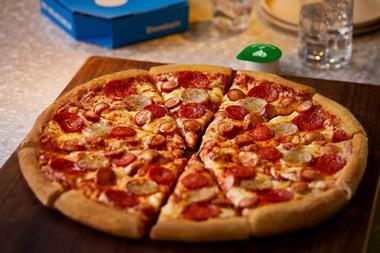

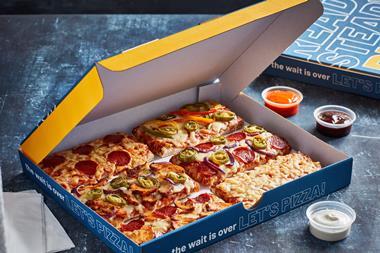

![Dominos_TheChick-Ain’t_VeganNuggets4[1]](https://d36hgjhwuw81py.cloudfront.net/Pictures/380x253/8/5/0/351850_dominos_thechickaint_vegannuggets41_592682.jpg)

